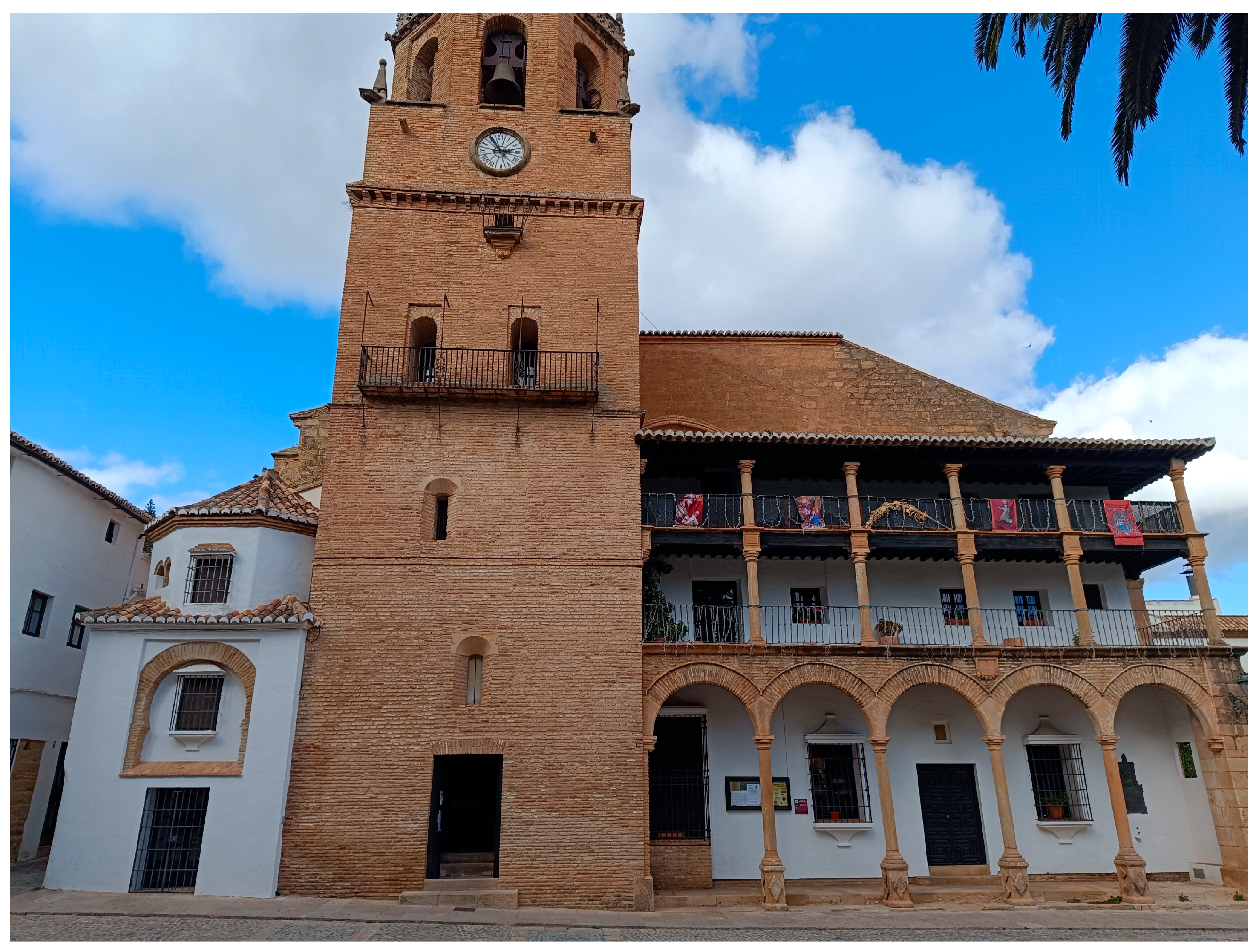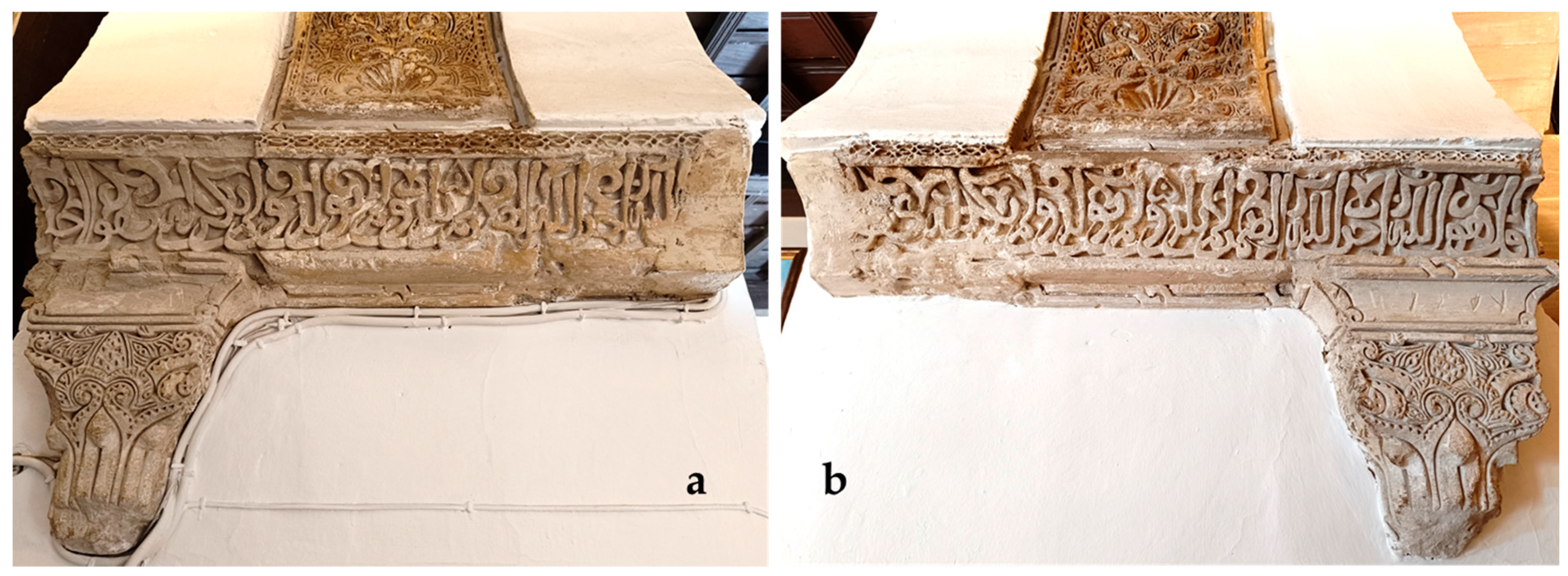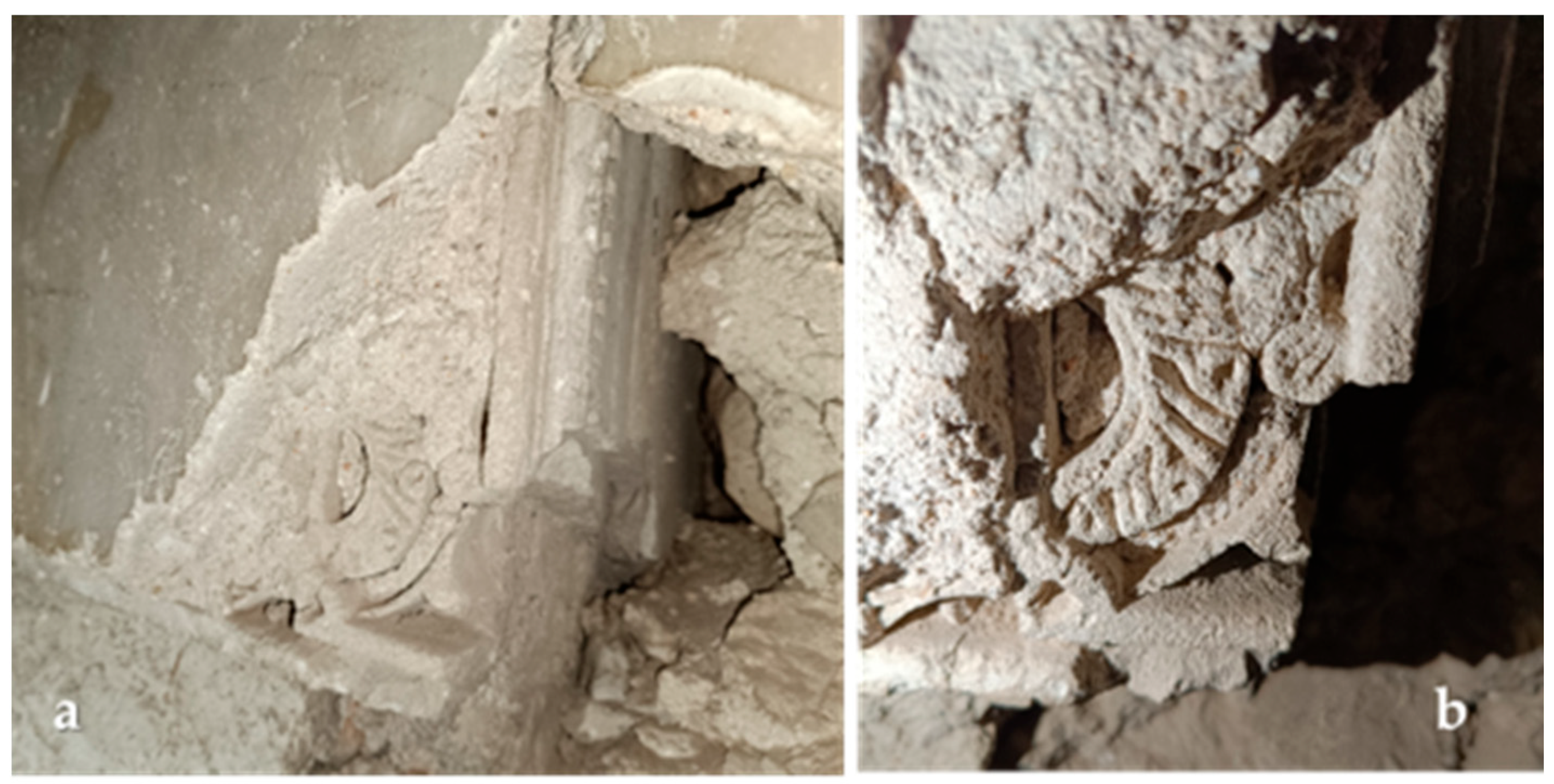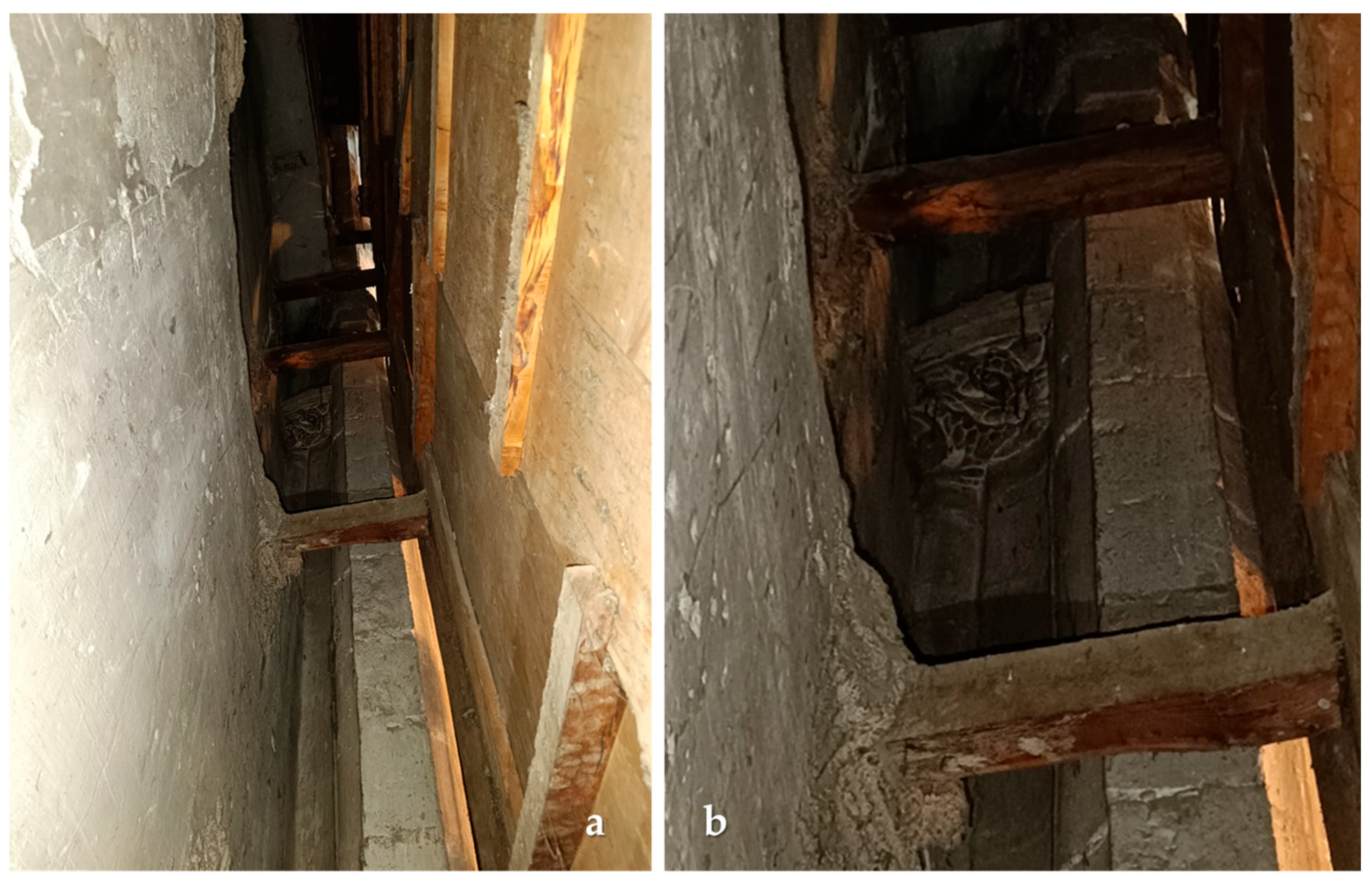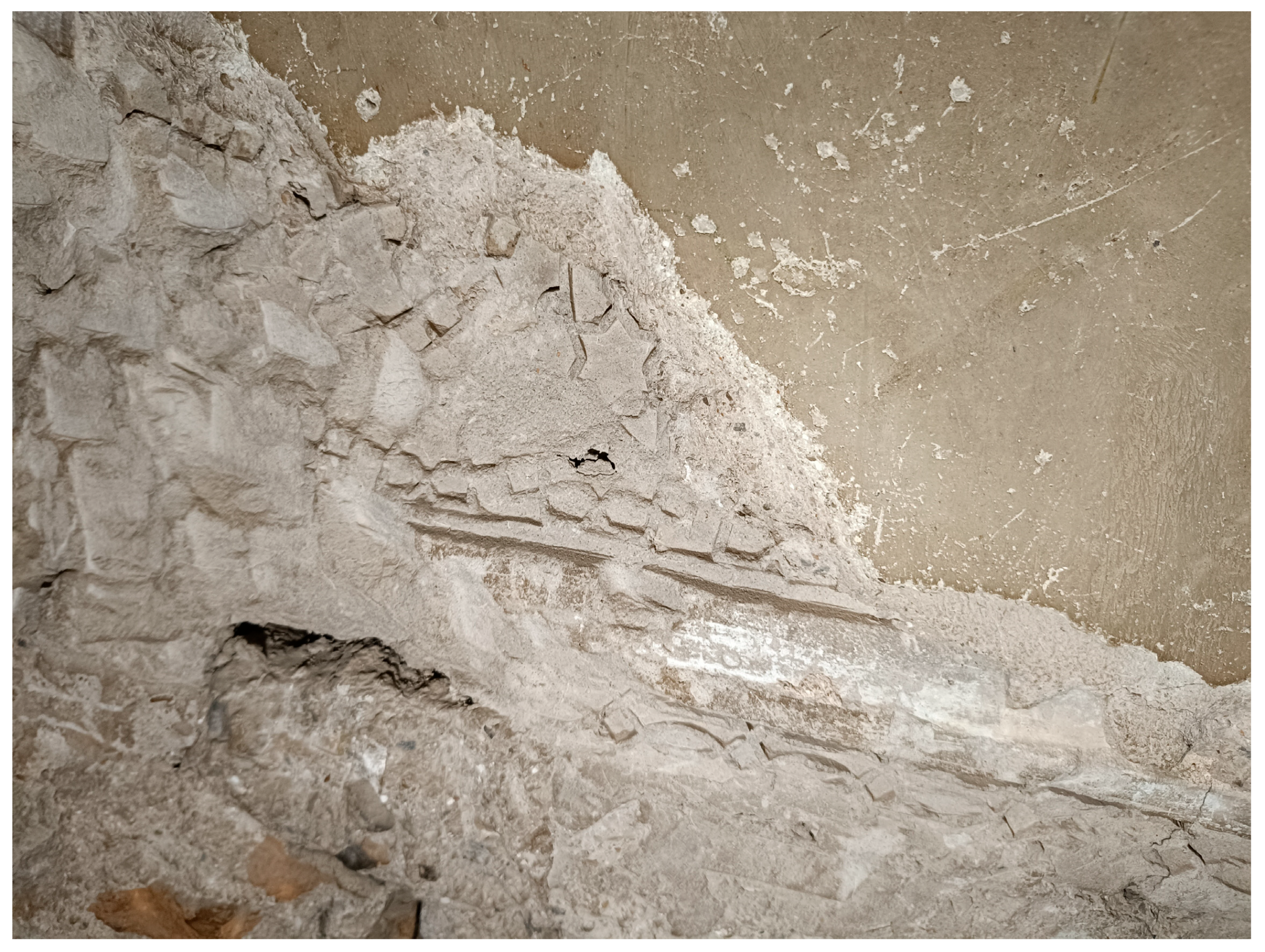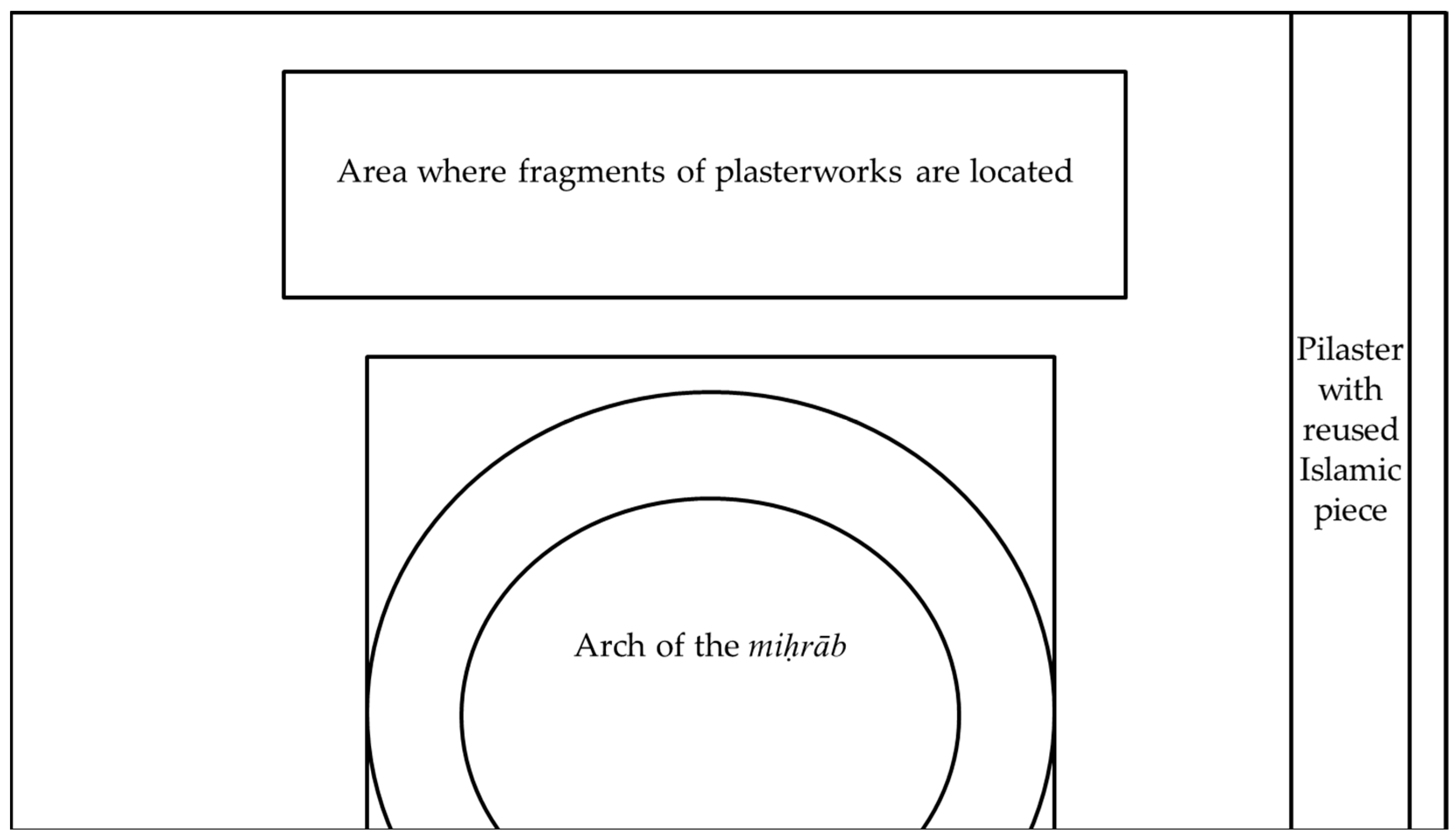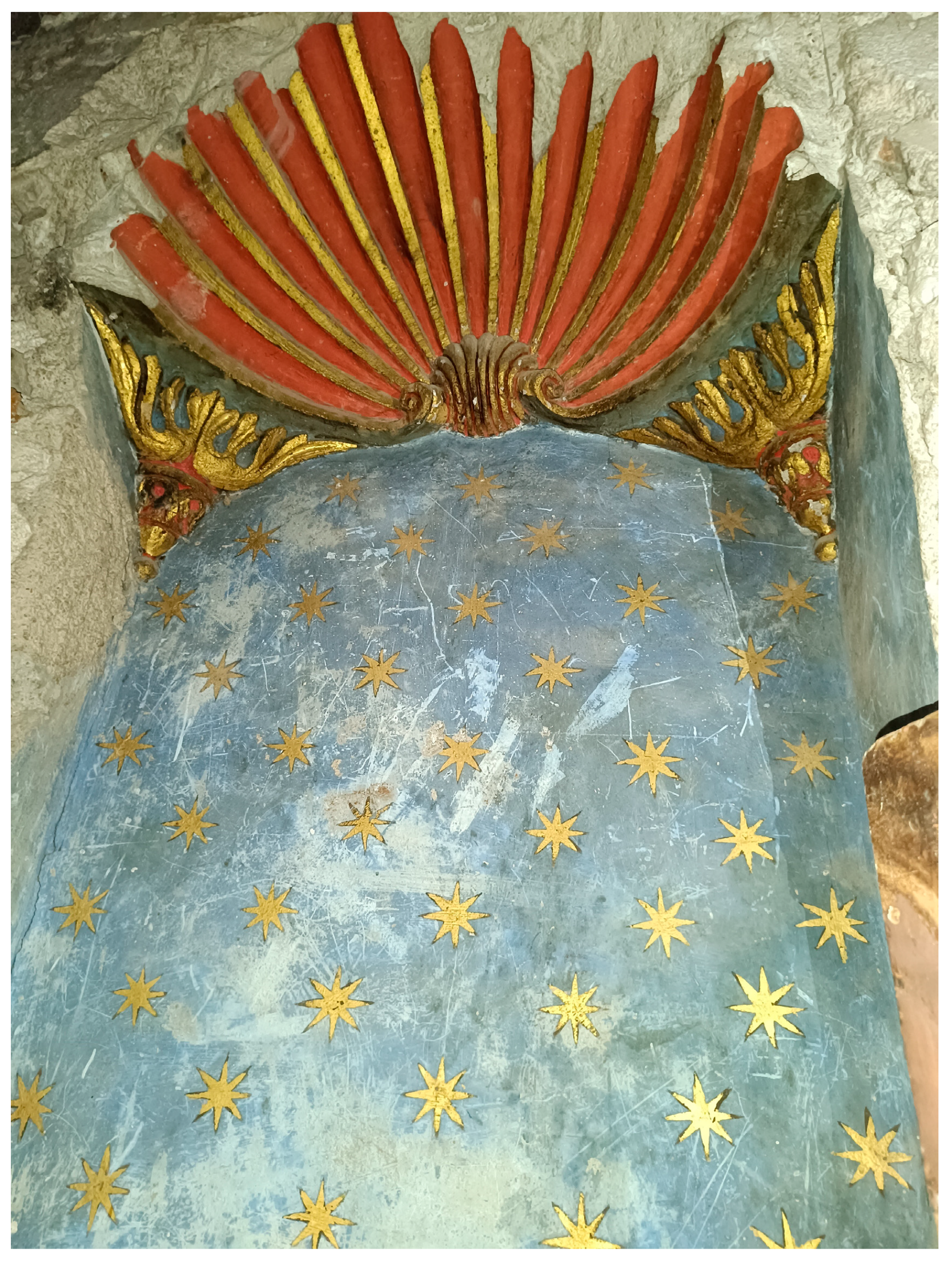1. Introduction
Amongst the Islamic remains detailing the town of Ronda’s history (Malaga, Spain), the remains of the ancient miḥrāb of the Friday Mosque are particularly noteworthy. These are located in the present-day church of Santa María de la Encarnación la Mayor, built following the Christian conquest on the site of the ancient Friday Mosque.
In order to garner a better understanding of the ancient
miḥrāb’s state, the alterations it has undergone over time, along with the architectural backdrop against which it is situated, it is essential to provid a brief overview of the building’s evolution. The site on which the modern-day church of Santa María de la Encarnación la Mayor in Ronda stands has historically acted as a veritable sacred ground. It has been the site of buildings belonging to different faiths. Hence, certain authors have stated that, on this site, there was already a Roman temple dedicated to Caesar Divinised (
Moreti 1867). The religious use remained continuously throughout the Visigoth domination, through the construction of a basilica and necropolis in the 6th–7th centuries (
Aguayo de Hoyos and Castaño Aguilar 2000). In this regard, in the 18th century,
de Rivera Valenzuela (
1766) mentioned that a tombstone was still preserved in the ancient
qibla wall, behind the Baroque altarpiece, bearing the inscription “IVLIO DIVO MUNICIPES”. Nevertheless, only secondary bibliographical sources and highly specific samples taken from archaeological prospecting have survived. This means that the previous religious uses of this area are only partially known.
In continuation of the tradition of a succession of temples on the same site, the placement of the Friday Mosque after the Muslim conquest of the town in 711 is also clearly established. However, there is still scarce written evidence pertaining to its size, structure, shape, and decoration. The essential part of the
qibla wall, where the
miḥrāb was integrated, remains in place, alongside the base of the quadrangular minaret, later transformed and rebuilt in the form of a bell tower. Moreover, a cubic structure that precedes it, used in the 20th century as the sacristan’s house, has similarly been preserved (
Corbacho Sánchez 2024) (
Figure 1).
This structure most likely corresponds to a
qubba, i.e., a type of Islamic building with a square floor plan and covered by a dome or a wooden crown-post ceiling. It was highly common for these to serve as
morabitos or burial places for saints venerated by believers. In this scenario, and regardless of the internal architectural alterations it may have undergone, the brick horseshoe arches on its fronts and the magnificent Nasrid wooden crown-post ceiling, featuring its rafter and collars and octagonal arrangement, come to the fore (
Ramírez González 2012).
It is worthwhile mentioning these three elements that have been partially or totally maintained in the Christian building, as they endow us with a clear idea of the symbolic, religious, and pragmatic respect that was shown at the beginning of the construction of the collegiate church (
Aguilar García 1979). In this regard, it must be considered that the
miḥrāb,
qubba, and minaret formed a single space in the ancient Friday Mosque. In other words, the only thing reused from the Islamic building was the
qibla wall and that part attached to it (
Figure 2). The rest of the building was demolished in the standard manner, which gave way to the building of a new stone masonry structure in different phases throughout the Modern Age.
Turning to the
miḥrāb, despite the quality of its ornamental plasterworks, references in the historiography to these remains are scarce. Only mentioned by
Amador de los Ríos (
1907)
1,
Torres Balbás (
1944),
Aguilar García (
1979), and
Pavón Maldonado (
1980), the material remains of the ancient
miḥrāb have yet to be studied in depth. Against this backdrop, the aim of this article is to analyse the material remains found in the
miḥrāb, including its Arabic inscriptions, plus the unpublished and non-visible remains of its plasterworks; to study the transformations in the
qibla wall after the town’s Christian conquest; and to propose preservation and valorisation measures to display these remains, whilst not damaging the 17th-century altarpiece that covers them.
To achieve these aims, the published research works tackling the ancient miḥrāb and the subsequent works of the church of Santa María de la Encarnación la Mayor between the 15th and 16th centuries, plus its aggrandisement at a later stage of construction, have been queried. Alongside this, significant fieldwork, including access to the rear of the 17th-century altar, has been carried out. This fieldwork enabled us to document the non-visible fragments of plasterworks of the qibla wall of the ancient Friday Mosque, as well as the non-visible remains of the 16th-century altarpiece.
After the introduction,
Section 2 describes the documented plasterworks of the ancient
miḥrāb in detail, both visible and non-visible elements located behind the 17th-century altarpiece. These hidden fragments were covered during the first transformations of the
qibla wall, when two layers of stucco were applied to build the 16th-century altarpiece. Due to their fragmentary state, they were analysed and grouped as per the decorative motifs they display, meaning certain hypotheses regarding their location have been raised.
In
Section 3, we analyse the historical transformation in the church and its impact on the
qibla wall. After the Christian conquest of Ronda, the church of Santa María de la Encarnación la Mayor was built in the place of the ancient Friday Mosque. Although
Amador de los Ríos (
1907) proposed that this first church must have been built in the final years of the 15th century or the early part of the 16th century, recent works have established that the first church was built in the beginning of the 16th century (
Fariñas del Corral 2014;
Soto Garrido 2019). Related to this first church, an altarpiece with niches and wall paintings was built, covering the plaster ornamentation of the ancient
miḥrāb. The primitive 16th-century altarpiece was replaced by a Baroque one in the 17th century (
El Sagrario altarpiece). At the dawn of the 20th century, the remains of the ancient
miḥrāb and the 16th-century altarpiece were revealed, which were then used for preparing spaces for burial sites. Since then, a section of the Islamic plaster ornamentation was recovered, albeit partially still hidden by the 17th-century altarpiece.
In view of this fact, in
Section 4, a recovery and valorisation plan is outlined. This includes preservation measures applicable to the remains of the ancient
miḥrāb and the 16th-century altarpiece, currently covered by the 17th-century altarpiece. A proposal is thus suggested to bring the remains into view without dismantling the 17th-century altarpiece.
Finally, a series of conclusions has been drawn. The significance of the material remains of the ancient
miḥrāb to garner a greater understanding of Ronda’s Islamic past has been commented on. Thanks to the formal appraisal of the plasterworks, the Marinid
2 work of this
miḥrāb, as proposed by
Torres Balbás (
1944) and
Pavón Maldonado (
1980), could be confirmed. Furthermore, a large part of the Arabic inscriptions of the
miḥrāb has been identified. Beyond that, the hidden remains of the decoration of the
qibla wall and the 16th-century altarpiece have been analysed for the first time. In summary, this study allows us to attain deeper knowledge of the former Friday Mosque in Ronda and the transformations that the
qibla wall experienced during the first decades of the Christian conquests and the following centuries.
3. Historical Transformations of the Church After the Christian Conquest and Their Impact on the Qibla Wall
Upon the incorporation of the town of Ronda into the Kingdom of Castile in May 1485, the Friday Mosque underwent the Christian sacralisation of its space and its cultural reuse, as in the cases of other ancient mosques in conquered Andalusi towns (
Carrero Santamaría 2011), in order to implement the new architectural project over time. The person entrusted with the consecration ceremony was the senior chaplain of the king’s army, Pedro Díaz de Toledo. Very early in the 16th century, significant shifts began to take place in the construction of the new church, albeit overburdened by the sluggish pace of progress caused by the scarcity of funds. From the year 1501, information has been unearthed regarding the need to acquire bells not only to announce celebrations, but also so that the temple could acquire a greater urban and religious standing (
Soto Garrido 2019). Merely seven years later, in 1508, the narrowness of the new building was considered while it was still under construction, bearing in mind the increase in population that the town experienced. There were proposals for enlargement still in force in 1520, by which time two of the three longitudinal naves had already been built. However, the lack of financial means curtailed the construction of the third nave, although contributions and aid from religious institutions in Ronda helped to complete it by 1534 (
Torres Balbás 1944).
3.1. The Late Gothic Church and the First Works in the Ancient Qibla Wall
The late Gothic structure of the church was thus practically completed, barring slight modifications and several repairs that arose due to natural disasters occurring in the 16th and 17th centuries (
Fariñas del Corral 2014). It is therefore a space featuring a rectangular floor plan and three longitudinal naves separated by pointed arches, offering light to the interior by means of twin openings. In turn, the supports were comprised of pillars covered with small columns and continuous friezes as capitals, with stone carvings in the form of cardine leaves, plus faunal and hybrid motifs (
Miró Domínguez 1987). The vaults are unlikely to have been made of stonework, nor did their building process adhere to standard patterns of the period, formed by star-shaped or tercelet vaults. If this had been the case, part or all of them would have been preserved, either in direct view or hidden by later vaults adapted to new aesthetic tastes. In view of this, the theory of the initial covering with
Mudejar wooden crown-post ceilings, replaced at the beginning of the 18th century by groin vaults and semi-spherical domes with plasterwork, gains weight (
Camacho Martínez 1981).
It is of the utmost importance to analyse the church’s positioning at that time in order to understand the actions defined in the area of the ancient qibla wall. In other words, Christian religious design would continue to be, in general terms, the same as in the Friday Mosque: the limit of the entrance area was where the entry to the choir stalls was located, probably including an entrance doorway. Therefore, the altar and main chapel on the opposite side correspond to the location of the ancient miḥrāb. Doubts surrounding the constructive intentions of this last segment of the building in the transition from mosque to church, for which different hypotheses have been raised, come to the fore here. The shortfall in terms of documentation in this regard is undeniable, and therefore, gaps that are difficult to interpret are left behind, although this work will attempt to elucidate aspects that may be deemed enlightening.
The first thing to consider is the fact that the qibla wall was probably the last evidence of the Friday Mosque to be affected in the recent Christian works, perhaps down to emblematic reasons, though largely for practical reasons. Three pointed arches formed the front of the chancel of the church. It is remarkable to see how they could be built without touching the previous wall. In other words, they opened narrow openings in this wall and embedded the jambs and haunches of the arches. This is proven by the evidence of the remains of the previous masonry around it. In theory, this would suggest that this was an action to avoid building new walls to which altarpieces, altars, or other types of artistic works would be fitted. This seems to have been the case with the lateral arches of the chancel, yet not with the central one, where the miḥrāb was located.
Put into perspective, regarding this space, the central arch is larger than those on the flanks, and it was also created with the same perfection both towards the inside and the outside of the church, i.e., on both sides. Indeed, the peak of the pointed arch still remains visible, in part, from the outside and above the portico galleries of the current main façade, as well as the start of one of the jambs embedded in the wall when entering through the door through which tourists visit. It is certainly noteworthy that such an action would have been undertaken on the stone supports if the ancient qibla wall were to remain standing. Concerning this fact, certain authors have proposed that this arch was an attempt to build a large entrance to the church; moreover, its disproportionate size does not suggest that this is the case. Furthermore, it seems that this area was originally intended to serve as the church’s chancel and that the entrance would have been on the opposite side or even on the sides. For this reason, the hypothesis of a large entrance throughout this central arch can indeed be considered unfounded.
Upon defining the arch’s characteristics, and thanks to the findings ascertained from this, the hypothesis that it could respond to the intention of representation as a triumphal arch cannot be disregarded. In other words, it would give entrance to the main chapel that would open onto the space of the adjoining square. Perhaps the shortfall in terms of funding, or other reasons of a technical nature, made its undertaking impossible, with the consequent dismissal of the initial project. If this had happened, as we believe it would have, the ancient
qibla wall would have been left standing to strengthen the front and provisionally enclose it in readiness for the aforementioned chapel to be built at a later date. Finally, this was not carried out, thus encouraging the preservation of an important part of the
miḥrāb. It seems that the plan in the aforementioned area of the chancel also included a type of vault in the section just before the triumphal arch, also without completion. This is suggested by the powerful ribs that jut out from the springing lines and disappear below the 18th-century pendentives (
Figure 14).
Having discarded the idea of the main chapel, which was certainly debated for much of the 16th century, the order of the chief magistrate Alonso de Espinosa Calderón to make the main square more regular and adapt it for diverse forms of entertainment at the end of the century forced the opening of balconies on its different fronts (
Moreti 1867). This issue also affected the collegiate chapter, which undertook the opening of three superimposed portico galleries (
Figure 1): the lower one on semicircular arches and the following lintelled ones, reformed in 1787, as emblazoned on a commemorative plaque. This action definitively discarded the idea of building the projecting main chapel, assuming they still intended to do so, already occupied by the arcades. On the other hand, these arcades covered, at the same time, the need to offer a standalone space for the baptistery and, later on, the historical archives.
When the ancient
qibla wall became part of the presbytery and integrated the altar, the aim was to cover any surviving evidence of the Friday Mosque. As a matter of fact, the niche of the
miḥrāb was destroyed, and the arch of its façade was walled in and out. The following action has only been unearthed through this study, owing to difficulties in terms of access and a shortfall in more deep-rooted research over recent decades. On approaching it, we have been able to verify that in the 16th century, a pictorial parietal altarpiece was painted onto the
qibla wall. In other words, the wall was covered with up to two layers of smooth mortar that concealed any Islamic artistic evidence, while its surface was covered with pictorial decorations that have almost entirely disappeared. Only slight occasional traces of colour have persisted; however, the two lateral niches opened into the wall have been maintained in an extraordinary state of preservation, with a quadrangular-shaped opening topped by a prominent shell on small vegetal squinches. The colours are dazzling, combining ochre and gold leaf on a blue background of golden stars. The 16th-century pictorial altarpiece must also have included other types of furniture that hitherto remain unknown (
Figure 15).
3.2. Transformations During 17th and 18th Centuries
It is assumed that the main altar remained with the 16th-century pictorial altarpiece until the second half of the 17th century. Then, the collegiate chapter commissioned the creation of a Baroque altarpiece, as part of the general construction and ornamentation of the church (
Figure 14). Once again, the almost total absence of documentation limits our ability to specify the subject in depth, yet certain specific information that has reached us mentions the work’s aesthetic features and the inscriptions it bears, which may help us to draw conclusions. The altarpiece is of major proportions, covering the entire central wall and the perimeter of the pointed arch, which overlaps the upper part with the body of the attic. It is a splendid timber-based structure featuring three high sections and three vertical lanes separated by voluminous Solomonic columns. It is precisely the arrangement of these columns that allows to date the piece to the 17th century, prior to the custom of replacing such supports with stipites, which became more common in the 18th century (
Romero Benítez 2012).
de Rivera Valenzuela (
1766) provides a clue to its origin by drawing attention to the coat of arms belonging to the bishop of Malaga, Fray Alonso de Santo Tomás, who held the post between 1664 and 1692, in the upper section.
Nonetheless, two commemorative plaques on the bases of the side parts indicate that it required a large part of a century for its ornamentation to be completed fully, including gilding, steaming, and polychrome of the structure and reliefs: “Se doró este retablo por las fábricas de las yglesias de esta ciudad año de 1773” (“This altarpiece was gilded by the factories of the churches of this town in the year 1773”). The altar is presided over by the Immaculate Conception, accompanied by a sizable relief unravelling the mystery of the Incarnation. When the altarpiece was completed, this space continued to serve as the church’s main altar while awaiting the completion of the new piece (
Sánchez López and Ramírez González 2003). In conclusion, the construction of the Baroque altarpiece meant that a large part of the ancient
qibla wall remained concealed thereafter, preventing any further direct intervention on it.
Upon completion of these works on the church of Santa María de la Encarnación la Mayor, in 1680, a powerful earthquake destroyed the northern part of the church. This inspired the notion to expand the space. Works began in 1684. These were hampered by technical, administrative, and economic issues (
Soto Garrido 2018). The slow construction process became embroiled in a lengthy lawsuit with the master Francisco Gutiérrez Sanguino, the contribution of architects such as Francisco del Castillo and Felipe de Unzurrunzaga, plus others entrusted with reviewing progress. Finally, work was completed in the 1920s (
Fernández Martín 2001). With the aforementioned enlargement of the church, the temple now faced in another direction, meaning that the chancel was located on the north side and the entrance of the church to the south. Thereupon, the former main altar, on the
qibla wall, became a secondary altar, located behind the new choir, and with the function of a tabernacle; in other words, the Baroque altarpiece mentioned above came to dominate what would then have been the sacramental chapel.
As has already been mentioned, the ancient
miḥrāb of the Friday Mosque was wholly concealed since the works carried out in the 16th century. Indeed, no evidence has been unearthed of its existence or preservation in the historiography until the contemporary period. Regardless of the above, this area of the church was the site of an illustrious burial in the 17th century, according to the antiquarian and historian Macario Fariñas del Corral. Fariñas was responsible for giving shape to the biography of Pedro de Ugarte, alderman of the city of Malaga and religious hermit in the desert of the
Virgen de las Nieves (El Burgo, Malaga, Spain), which he founded. His exemplary life earned him great renown in the region, to the point that the clergy of Ronda obtained the transfer of his remains in 1587, six years after his death. The intention was to honour him with a more dignified burial in the altar of the Immaculate Conception in the chapel of the
Virgen del Socorro in Ronda. At the request of the bishop of Malaga, Fray Antonio Enríquez de Porres, in 1635, the body was moved for a second time to the main altar of the collegiate church of Santa María de la Encarnación la Mayor, on “the pedestal of the presbytery” (
Fariñas del Corral 2014).
Macario Fariñas, an eyewitness to the event, gave an account in which the grave was located next to an earlier one where the incorrupt body of a younger son of the first magistrate of Ronda, Antonio de Fonseca (1485–1487), laid. Ugarte’s tombstone bore a long epitaph containing a lyrical expression in Latin. Although both tombs were around the floor of the niche of the
miḥrāb, the arch of the latter must have remained hidden from view, as Macario Fariñas failed to mention this in his major work on the Antiquities of Ronda. Nor did such renowned local historians as Juan María de Rivera Valenzuela, in the 18th century (
de Rivera Valenzuela 1766), and Juan José Moreti in the 19th century (
de Rivera Valenzuela 1766).
It was the journalist Francisco Páez Ortiz, editor of the newspaper
La Nación de La Habana and correspondent of
El Cronista, who reported on the work that arose renewed interest in the
miḥrāb through an extensive article entitled “Removiendo los escombros en una cathedral” (“Removing rubble in a cathedral”). It was in 1920 when the journalist, passing through the town, befriended the parish priest, Eugenio Sánchez Maldonado. He was given a tour of the renovations carried out to the rear of the altarpiece of
El Sagrario, with the discoveries brought to light. Conversely, the arch itself and the decorative plasterworks around it, and on the other, just beneath the arch, the tombstone and burial of Pedro de Ugarte (
Fariñas del Corral 2014). Thus, since 1920, the arch of the
miḥrāb of the ancient Friday Mosque was uncovered, which has remained unaltered to the present day.
4. Recovery and Valorisation Plan
The tasks to restore the miḥrāb’s arch undertaken in the 1920s consisted of opening the arch at the back, creating a gap under it limited by the altarpiece. This action enabled access for its viewing. However, it still affords a somewhat restricted view due to the narrowness of the space. This allows to examine more thoroughly the intrados of the arch and the capitals on which the haunch is placed, though with greater difficulty insomuch as the area corresponding to the front of the voussoirs and the alfiz. For this reason, several decades ago, the decision was made to incorporate a mirror on the back of the altarpiece. By adding a suitable inclination, the plasterworks may be viewed from a more appropriate distance while more comfortably. This was a particularly wise solution, given that the space of the ancient miḥrāb is located in a particularly bustling area, mainly due to the flow of visitors entering and leaving the monument.
Nevertheless, one senses that the Andalusi remains would not fit properly into the visitors’ itinerary to the building. Thus, significant actions would be necessary with a view to boosting its historic value. In this regard, it is worthwhile indicting that two restoration actions would be required at different heights. On the one hand, and this is already underway, the governing body of the church has applied to the Andalusian Regional Government’s Heritage Department for permission to raise the clay tile floor of the old baptistery and archive, which now serves as a tourist entrance area. First of all, the high level of protection of the building as an Asset of Cultural Interest (BIC)
8 must be borne in mind, meaning that any action on it requires previous plans and properly justified final reports, all of the foregoing pending approval by the regional public authorities.
Although the intention of the Diocese of Malaga was only to improve the entrance for visitors to the monument, our involvement in the matter through scientific guidance contributed to including a specific archaeological prospection of the ground around the arch of the miḥrāb, which is still awaiting approval. This would be a significant first step towards raising the visibility of this site, as part of a visit that would then feature greater autonomy and an enhanced educational and expository sense. This archaeological intervention would thus endeavour to recover the delimitation of the miḥrāb niche. It would allow for it to be interpreted as a whole, while installing therein an appropriate permanent display, without detracting from its protection, by covering it with a translucent methacrylate paving or, failing this, with a special glass type. Undoubtedly, it would be vital to illuminate the surroundings and place explanatory panels properly, in order to foster their interpretation in tandem with the constructive phases of the building. Conversely, if the aforementioned tombs in the same place are discovered, they would also need to be integrated into the exhibition space.
The restoration of the front area of the ancient qibla wall will be vastly more arduous to undertake. Access to the hidden area had to be gained through the right rectangular panel of the first storey of the altarpiece, at the beginning of the side part, and between the two column bases. This panel serves as a lowered door, implemented at the time, to enter this space and facilitate structural repairs or specific damages. Still, above all, this passageway connects with a narrow wooden staircase between the qibla wall and the altarpiece, which ascends diagonally up to the low central niche where the image of Saint Anne teaching the child Virgin to read is located today. Incidentally, this stairwell is currently unusable and in a notable state of disrepair, so much so that it is in danger of collapsing.
Upon entering the interior, not without difficulty due to the lack of lighting and the narrowness of the space, it became possible to see how the ancient
qibla wall had been transformed over the 16th and 17th centuries, thus allowing us to gain a more accurate understanding of the situation. Despite the continuous detachments of the surface layers of the wall, which currently endanger the integrity of the wall along with the actual altarpiece’s sturdiness, have allowed for the unearthing of remains that have been concealed for a long time, i.e., plasterworks with plant decoration (
Figure 7,
Figure 8,
Figure 9 and
Figure 10), star-shaped and geometric motifs (
Figure 11 and
Figure 12) of enormous artistic value. Indeed, at the beginning of the 16th century, the Andalusi decoration on the wall above the staircase was covered by up to two layers of mortar, at least in the area inscribed in the upper part of the
alfiz and its outline. However, as we moved away from this central point, a section of the wall was uncovered in which the previously existing wall had been deliberately chipped away, with a view to adhering to styles that included the opening of the new renaissance niches on the sides. The situation towards the highest section remains unknown as this is currently inaccessible.
In summary, the historical interventions on the ancient qibla wall tended to oscillate around an intermediate line, fluctuating, deliberately or not, between conservation and destruction. Apart from the actions stated in this regard in the 16th century, worthy of addition is the one occurring at the end of the 17th century with the installation of the new Baroque altarpiece. It would appear, as was noted, that during the restoration, the wall was hardly touched and was left as it had remained for a long time, removing, of course, the items of furniture that might were attached to it. However, the new altarpiece needed anchors to fasten it to the wall, meaning, as was customary, numerous perforations were made in order to insert wooden dowels strengthened with mortar. This action caused obvious damage to the qibla wall.
From inside the gap between the altarpiece and the
qibla wall, the continuation of the carving of the late Gothic stone supports of the pointed arch is visible towards the sides. Particularly noteworthy is that even on these elements, pieces reused from the Friday Mosque have been given a new use. Specifically, the support on the right side has, below the border, carved with cardine leaves, an interesting fragment decorated with trepanning, which, given its curvature and upper moulding, could well correspond to an Andalusi capital or corbel (
Figure 10).
After having consulted with restorers specialising in this type of restoration work, a project may be proposed to return the area to its former glory, which could be embarked upon should the authorities approve it. Adhering to criteria that are invariably respectful of the objet d’art that have come to replace and cover the original over the passage of time, as if it were a true palimpsest, it can be determined firstly that the Baroque altarpiece cannot be damaged. Furthermore, it is unfeasible, both from a technical and financial standpoint, to intervene at the front of it. In this regard, the Andalusian Historical Heritage Law 14/2007 of 26 November 2007 states in Article 20, for assets listed in the General Catalogue, that “restorations will respect the contributions of all existing periods, as well as the patinas that constitute the value of the asset itself”.
Thereby ruling out this option, the most feasible solution would be to undertake the action from the lower part of the arch of the miḥrāb, that is, from the access it affords onto the area of the visitors’ entrance. In order to facilitate and reduce the costs the work entails, it would be advisable to work in the space available between the qibla wall and the altarpiece. It is true that this space is somewhat narrow; it is still wide enough to withstand the scaffolding and allow for work to be performed vertically. That said, in order to achieve this, it is essential to clear the space of all kinds of obstacles. The first one is the internal staircase of the 17th-century altarpiece, which, as we pointed out above, is in a clear state of disrepair and presently serves no purpose. Moreover, it is now bereft of any artistic interest, and its dismantling would in no way harm the general structure of the work. The hindrance of some of the dowels that hold the altarpiece to the wall would also be assessed, either by avoiding them in the installation of scaffolding, or by dispensing with them, even if this would mean bolstering the connections through different techniques.
Continually adhering to suitable criteria in terms of reversibility, in which reconstruction is avoided unless original parts can be used as models, the idea is to rescue the plasterworks hidden by at least two layers of lime mortar and limestone. Most likely, certain loss of reliefs, clogging of cavities, deposit of dirt, and a certain level of disintegration and powderiness will be unearthed. In other words, by means of conservative treatments, the covered areas will be recovered, while stabilising and giving structural solidity to the whole. The solution that is put forward is grounded on mechanical removal (micro-brushes and/or scalpels) of the layers superimposed on the plasterworks, followed by pre-consolidation by injection or impregnation with ethyl silicate, Paralloid B72, or nanotechnological formulations currently in use, in areas of disintegration or cohesion. Finally, loose fragments or fragments in danger of detachment will be fixed, mechanically dry cleaned, and finally protected. A successful example of this type of recovery is the one carried out in 1992 on the inner front of
El Sagrario Gate of Malaga Cathedral. It was a major success in bringing to light the reliefs, coats of arms, and niches of the primitive late Gothic work in a perfect state of preservation (
Montijano García and Cuevas del Barrio 2012).
Once the Islamic plasterworks were restored, and while waiting to examine the remains that were recovered and the state they are in, a proposal is submitted for their enhancement. It would be essential to leave the gap between the qibla wall and the altarpiece free, in order to be able to observe the restored plasterworks from below. In this case, it would be necessary to install a low-emission LED lighting system to bring the details and tones to the fore. Given the narrowness of the space and the height where it is located, it is proposed that a system of magnifying mirrors be installed to afford more comfortable viewing. However, this will have to be appraised when the restoration is completed. Moreover, the placement of explanatory panels about this heritage asset in relation to its history, composition and aesthetics, including the recovery of an essential part that has been hidden for so long, should be installed.
5. Conclusions
This study helps us further our knowledge of the transformation of the Friday Mosque in Ronda into the church of Santa María de la Encarnación la Mayor after the Christian conquest of the town. For the very first time, the material rests in the qibla wall that remained hidden by the 17th-century altarpiece has been brought to light. These remains reveal how the plasterworks of the qibla wall were covered by at least two layers of mortar in the 16th century to build a pictorial altarpiece, which was also dismantled to build the 17th-century altarpiece of El Sagrario. The documentation of the pictorial altarpiece and of the fragments of the Islamic plasterworks is this work’s standout contribution.
Alongside the above, for the first time, the remains of the
miḥrāb façade have been studied in depth, including not only a formal analysis, moreover the identification, transcription, and translation of its Arabic inscriptions. Thanks to the formal analysis of the plasterworks, the Marinid work of this
miḥrāb, as proposed by
Torres Balbás (
1944) and
Pavón Maldonado (
1980), could be confirmed. As well, the different constructive phases of the church of Santa María de la Encarnación la Mayor have been detailed, including innovative details revealed through the fieldwork.
Due to the significance of the remains documented in the qibla wall, a plan for recovering and valorisation was submitted, without damaging or dismantling the 17th-century altarpiece. It includes the mechanical removal of the layers superimposed on the plasterworks, followed by pre-consolidation in areas of disintegration or cohesion, and the fixing of loose fragments or fragments in danger of detachment, mechanically dry cleaning, and finally protection. As previously mentioned, it would be essential to leave the gap between the qibla wall and the altarpiece free, in order to be able to observe the restored plasterworks from below, with the installation of a low-emission LED lighting system and of a system of magnifying mirrors.
In summary, this study reveals the richness of the history of the ancient Friday Mosque in Ronda and unveils many details of the transformation of the qibla wall for the construction of the church of Santa María de la Encarnación la Mayor. Our hope is that once these remains are disclosed, they can be put on view to visitors in the near future, through their restoration and valorisation.
